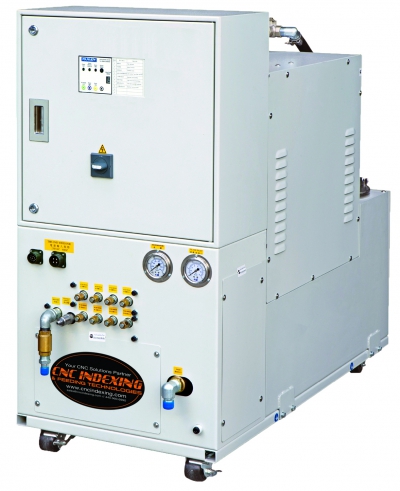
Four high-pressure coolant systems from machine tool equipment and accessory supplier CNC Indexing & Feeding Technologies each are engineered to match the production and economic requirements of differing manufacturing environments. For any manufacturer, the addition of high-pressure coolant capability increases productivity by enabling use of increased feeds and speeds, boosting workpiece quality and surface finish, and reducing manufacturing costs via increased tool life.
The HPC-400 HPCS is ideal for lathe and vertical mill applications and for shops that have a limited budget but seek the advantages of high-pressure coolant. The system’s 8 gpm gear pump for water-based coolant is adjustable from 75 psi - 427 psi, and an on-board transfer pump is standard.
The HPC-1000system offers versatility in applications on horizontal and vertical milling machines as well as lathes, and can be used in conjunction with other manufacturing equipment. The system’s 8 gpm, 7.5 hp gear pump system for oil- and water-based coolant is adjustable from 75 psi – 1,000 psi. An on-board transfer pump, 37-gallon reservoir tank and 4 port outlets are standard.
The HPC-1500 HPCS achieves the higher flow rates needed to utilize tools with large coolant orifices. The system’s 8 gpm, 7.5 hp gear pump handles either oil- or water-based coolant and is adjustable from 75 psi – 1,500 psi. The unit features an on-board transfer pump, 37-gallon reservoir tank and four port outlets.
The HPC-2000, CNC Indexing’s largest standard high pressure coolant system, employs oil- based coolant only and is ideal for CNC Swiss lathe machine tool applications. The system’s 6 gpm, 10 hp gear pump is adjustable from 75 psi - 2000 psi, and the unit features an on-board transfer pump, 37-gallon reservoir tank, eight port outlets, and an oil chiller.
In addition providing four different standard high pressure coolant systems, CNC Indexing also can custom-build systems tailored to specific production needs, such as those offering 2,500 psi and higher with multiple preset pressures.
Steve Smith, president of CNC Indexing & Feeding Technologies, said, “Our company’s comprehensive selection of high-pressure coolant systems will enable any shop to take advantage of the productive and economic advantages of high-pressure coolant technology.”
Contact Details
Related Glossary Terms
- computer numerical control ( CNC)
computer numerical control ( CNC)
Microprocessor-based controller dedicated to a machine tool that permits the creation or modification of parts. Programmed numerical control activates the machine’s servos and spindle drives and controls the various machining operations. See DNC, direct numerical control; NC, numerical control.
- coolant
coolant
Fluid that reduces temperature buildup at the tool/workpiece interface during machining. Normally takes the form of a liquid such as soluble or chemical mixtures (semisynthetic, synthetic) but can be pressurized air or other gas. Because of water’s ability to absorb great quantities of heat, it is widely used as a coolant and vehicle for various cutting compounds, with the water-to-compound ratio varying with the machining task. See cutting fluid; semisynthetic cutting fluid; soluble-oil cutting fluid; synthetic cutting fluid.
- gang cutting ( milling)
gang cutting ( milling)
Machining with several cutters mounted on a single arbor, generally for simultaneous cutting.
- lathe
lathe
Turning machine capable of sawing, milling, grinding, gear-cutting, drilling, reaming, boring, threading, facing, chamfering, grooving, knurling, spinning, parting, necking, taper-cutting, and cam- and eccentric-cutting, as well as step- and straight-turning. Comes in a variety of forms, ranging from manual to semiautomatic to fully automatic, with major types being engine lathes, turning and contouring lathes, turret lathes and numerical-control lathes. The engine lathe consists of a headstock and spindle, tailstock, bed, carriage (complete with apron) and cross slides. Features include gear- (speed) and feed-selector levers, toolpost, compound rest, lead screw and reversing lead screw, threading dial and rapid-traverse lever. Special lathe types include through-the-spindle, camshaft and crankshaft, brake drum and rotor, spinning and gun-barrel machines. Toolroom and bench lathes are used for precision work; the former for tool-and-die work and similar tasks, the latter for small workpieces (instruments, watches), normally without a power feed. Models are typically designated according to their “swing,” or the largest-diameter workpiece that can be rotated; bed length, or the distance between centers; and horsepower generated. See turning machine.
- milling
milling
Machining operation in which metal or other material is removed by applying power to a rotating cutter. In vertical milling, the cutting tool is mounted vertically on the spindle. In horizontal milling, the cutting tool is mounted horizontally, either directly on the spindle or on an arbor. Horizontal milling is further broken down into conventional milling, where the cutter rotates opposite the direction of feed, or “up” into the workpiece; and climb milling, where the cutter rotates in the direction of feed, or “down” into the workpiece. Milling operations include plane or surface milling, endmilling, facemilling, angle milling, form milling and profiling.
- milling machine ( mill)
milling machine ( mill)
Runs endmills and arbor-mounted milling cutters. Features include a head with a spindle that drives the cutters; a column, knee and table that provide motion in the three Cartesian axes; and a base that supports the components and houses the cutting-fluid pump and reservoir. The work is mounted on the table and fed into the rotating cutter or endmill to accomplish the milling steps; vertical milling machines also feed endmills into the work by means of a spindle-mounted quill. Models range from small manual machines to big bed-type and duplex mills. All take one of three basic forms: vertical, horizontal or convertible horizontal/vertical. Vertical machines may be knee-type (the table is mounted on a knee that can be elevated) or bed-type (the table is securely supported and only moves horizontally). In general, horizontal machines are bigger and more powerful, while vertical machines are lighter but more versatile and easier to set up and operate.






